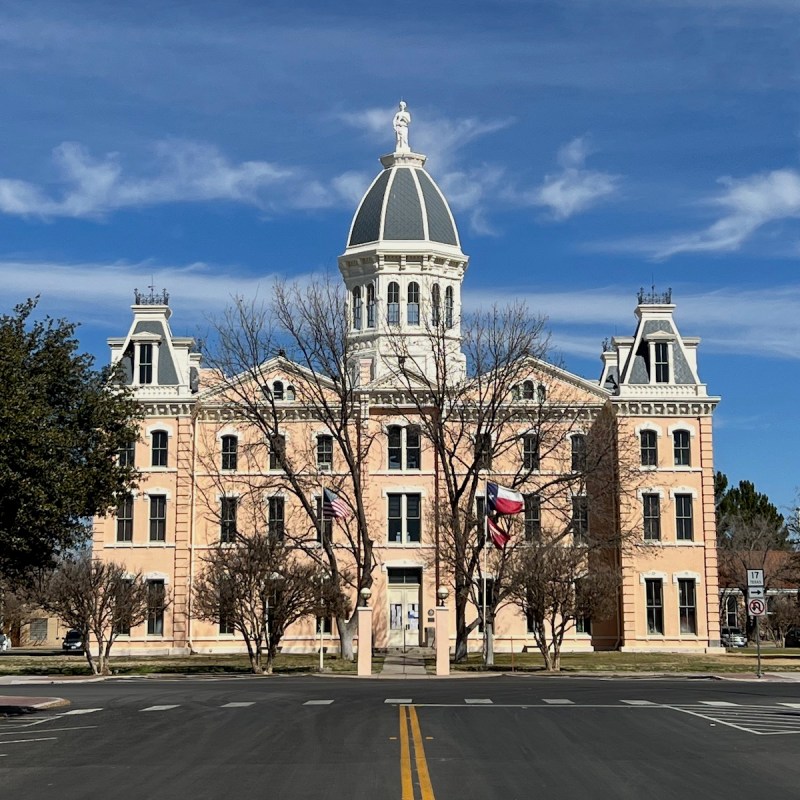
The southern route across Texas is U.S. 90. It takes you from San Antonio in the east to Van Horn in the west. Over the course of 400 miles, the terrain changes, the weather changes, and it is a great way to experience “old Texas” before Interstate 10 became the preferred travel route.
Videos by TravelAwaits
Traversing U.S. 90 is a great driving trip with plenty to see and do along the way. The best times to go are spring and fall. Winter will be cold and possibly snowy in the higher elevations of the west. Summer is very hot in the lower elevations — but in the mid-80s in the western towns with cool nights.
There are plenty of unique stops on this route, from “God’s Country” in the east to high-elevation railroad towns in the west. Welcome to southern Texas!
1. The Gateway Town: Hondo
“This is God’s Country” is the Hondo town slogan, made famous by a billboard that asked people to slow “the hell” down as they entered the town. The slogan has stuck and gives a flavor to this historic town 40 miles west of San Antonio.
Hondo was made famous in part by the Louis L’Amour novel of the same name and the film adaptation starring John Wayne. The railroad came through in 1881 and continues to dominate the landscape of this town. There is a Medina County Museum in the old railroad depot, and the main street through town has been preserved, showing the 1901 Hondo National Bank building.
Tripadvisor gives a thumbs up to Heavy’s Barbecue, which offers traditional Texas fare in a rustic setting.
Pro Tip: It’s two hours from Hondo to the next major stop. Watch your fuel tank and your water. You’re heading into the desert.

2. Amistad National Recreation Area
Desert and an increasing elevation accompany your arrival into Del Rio. Most people who live here are linked to Border Patrol, Laughlin Air Force Base, or the border crossing to Ciudad Acuña in Mexico. Many retirees fill out the population.
The real jewel of the area is the Amistad National Recreation Area, 8 miles west of the city. Amistad, a word meaning “friendship” in Spanish, is a reservoir formed by a dam on the Rio Grande as it curves between the United States and Mexico. Boating, some hiking, swimming, and fishing are enjoyed here.

The campgrounds are no frills and do not take reservations but are worth the effort to camp there. The reservoir water is incredibly beautiful, and the white limestone rocks are a stark contrast, adding to the geographical brilliance. You can watch military jets fly low and land at the Air Force base, right from U.S. 90. There are plenty of Mex and Tex local restaurants on both sides of the border, as well as most chain eateries.
There are paved roads in the campgrounds and day-use area, but otherwise, this is not a wheelchair-accessible location.
Pro Tip: Take the Texas 79 loop around the city for nice views of the desert and Mexican mountains, and to avoid the endless stop-and-go traffic in town.

3. Seminole Canyon State Park
This small state park is 30 minutes from Del Rio. Seminole Canyon is mainly a walking and biking park, with 10 miles of trails. The canyon is small but includes two sections of petroglyphs made by people 7,000 years ago. One panel is accessible only by a park ranger walking tour, which has moderate stairs down into the canyon (and back up) as well as a moderate hike to the site. The other petroglyph site is only accessible by private tour boat and includes walking to the site after landing on the shore.

Pro Tips: As you head west, you’ll cross the historic Pecos River. There is a visitor parking area and pullouts near the bridge. Also note that to get to the railroad towns, you will ascend to over 4,500 feet to the high plain. Expect headwinds going west, which may require extra fuel.

4. Marathon
Marathon, the first of the railroad towns on this list, is 2 hours west of Seminole Canyon park and is a hidden gem of a place.
Marathon considers itself to be the start of the western frontier. The historic, adobe Gage Hotel is the primary attraction in this tiny town and includes a gourmet restaurant in the hotel and the Brick Vault Brewery and Barbecue across the street. The Brick is very casual and has good food and craft brews.
The Gage also maintains a 27-acre garden in town that is open and free to the public every day. It has an off-leash dog area and a putting green, which was a totally random find.
For me, however, the main attraction is Marathon’s starry skies. The Marathon Motel & RV Park and Marathon Sky Park are under a Class 1 dark sky, which is the darkest classification on the Boris Light Pollution Scale. Countless stars and fascinating space phenomena are visible. The parks have an observatory and astronomers who help visitors see the various constellations. On the cold night I was there, 20 of us peered through telescopic binoculars, oohing and ahhing at the planets and stars. It was a lot of fun for free.
The daytime views in Marathon are stunning, as well, and the trains, including Amtrak, come through frequently.
5. Alpine
Alpine is the next railroad town and is 30 minutes away. It is the largest of the railroad towns and sits at 4,500 feet. This town has plenty of services, hotels, and most importantly, gas. There is a museum in town, some historic buildings, and local eateries. I passed through, as Marfa was my main destination.
Pro Tip: There are two very convenient picnic stops between the three cities. They are easy on/off stops with covered picnic areas. Any rest stop in Texas allows for a free overnight stay, as long as you do not stay longer than 24 hours.

6. Marfa
The next railroad town, Marfa, is a quirky place and is worth the time to explore. It’s pretty much at the end of the road going west — go south to get to Big Bend national and state parks, or go north to Van Horn and El Paso.
As an end-of-the-line town, Marfa has taken on a mystique. It has a lot of art galleries, artists in residence, and a great deal of art for sale in shops. Many artists are celebrated, and you’ll find some outdoor sculptures, as well.
Ballroom Marfa is a major art gallery and performative art center in town. You’ll also find the sprawling complex of the famous artist Donald Judd. He has a studio, home, and gallery downtown, set in repurposed historic buildings and new galleries.
There is a lovely courthouse square flanked by historic buildings, including the national historic landmark The Paisano Hotel. The 1956 Western Giant was filmed nearby, and the cast, including James Dean and Elizabeth Taylor, stayed at The Paisano.
There are a dozen cool cafes and restaurants along with food trucks for dining. One of the places I tried to visit is Food Shark, a food truck. Sadly, a handwritten note was taped to a folding chair at the entrance of the property that read, “Closed until not.” That sums up the nature of Marfa. It’s a fun town to wander around and enjoy the ambiance. You’ll even find the local public radio station housed in a new building that looks like a repurposed 1930s gas station. It fits right into the local culture.
Pro Tip: Cafes and small restaurants may only be open on the weekends during the colder seasons.
Besides art, Marfa is known for the sporadic and unexplained lights in its night sky, the Marfa Lights. There’s a viewing pavilion and rest stop built for you to catch a glimpse (if you’re lucky). Head east of town about five miles on U.S. 90, and you’ll find plenty of people each night sitting or standing in the dark, gazing at the horizon. The area is a decommissioned World War II airbase that allows great sightlines for viewing these seemingly unexplainable lights.

I enjoyed my stay in town at the cheekily named Marfa Yacht Club. You can rent one of their classic Airstream trailers for your visit or bring your own, as I did! It sits in the midst of the valley with great views of the mountains.
It’s windy and dusty on the high plain. It can be hot in the summer, and winter nights get below freezing. But the Guadalupe Mountains to the north and the Texas Chinati Mountains far to the south create a beautiful landscape vista in Marathon, Alpine, and Marfa.
Bonus: Valentine
Venture north of Marfa to the town of Valentine to see the unique outdoor sculpture, the Prada Marfa Boutique. There is nothing else open in this town, but this attraction draws a crowd. The Prada “store” was commissioned by Ballroom Marfa in 2005 and is a replica of an actual Prada store, right down to its authentic merchandise. This eclectic piece was a busy stop on the side of the road the weekday morning I visited.
End Of The Road
U.S. 90 ends 30 minutes up the road in Van Horn, where you can catch I-10 to go to El Paso or San Antonio.
This road trip is rich in history, from prehistoric times to ranchers and railroads. Sadly, there is little attention given to Native American history in the area. Historical markers note battles with Mexico and the advent of “settlers.” The local museums celebrate the taming of the land and the advent of railroads, along with noting the colorful tales of bank robbers and Wild West outlaws. The scenery is worth the trip, though, as are visits to the towns and natural settings that are authentic and quirky.
Related Reading:
